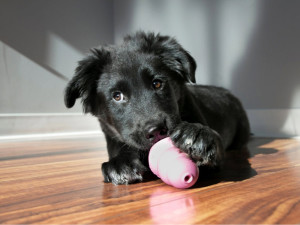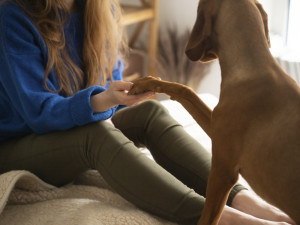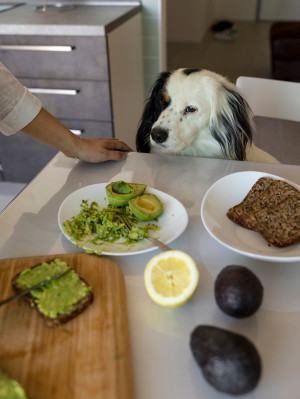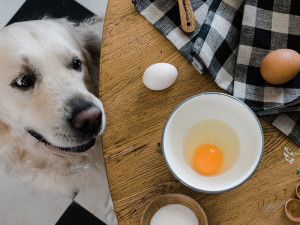Peanut Butter Is the Best Snack. Can Your Dog Have It?
Peanut butter is widely considered one of dogs’ favourite snacks (and a great bribery tool) – but how much is too much?
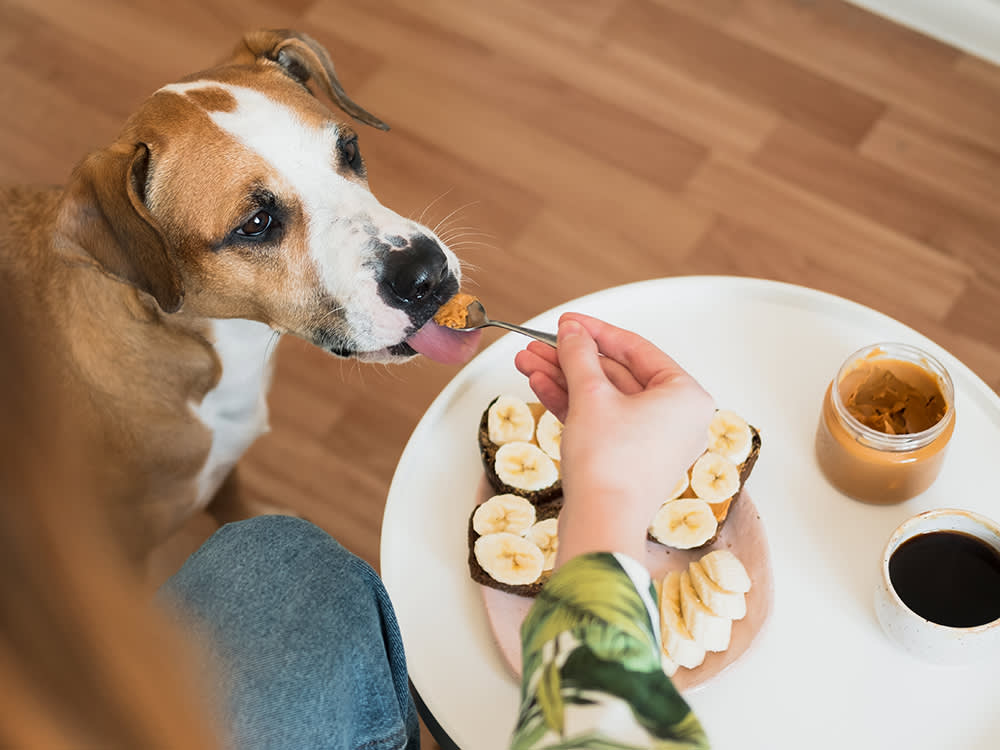
Share Article
Peanut butter. It’s one of those treats that humans and dogs can agree on; it’s super-enticing to dogs, and it’s nutrient-dense with plenty of health benefits. It’s functional, too: it can be used as an aid for keeping dogs entertained when you’re away, for hiding pills, and as a training reward. While peanut butter is a healthy and delicious treat for most dogs, there are a few caveats to watch out for, like xylitol, which is toxic to dogs. Let’s start with a few reasons why peanut butter can be a great treat to add to your dog’s balanced diet.
Can dogs have peanut butter?
“Peanut butter has healthy fats and protein that are good for your dog,” says veterinarian Dr Amber Karwacki of Heart + Paw Veterinaryopens in new tab. You might think that peanuts are nuts, but they’re actually a legume, like soybeans and lentils. Peanuts and tree nuts are similar in their taste and nutritional profile as they’re all rich in healthy unsaturated fats and fibre. And dogs love that nutty smell mixed with the sweet and salty flavours.
Do you like creamy or crunchy peanut butter? Dogs like both. It’s safe for dogs to have smooth and crunchy peanut butter. Just like you had very specific peanut butter preferences as a child, each dog has their own preference, though the smooth variety might be easier to lick and spread. And peanut butter isn’t just for older dogs – puppies can have peanut butter, too.
The nutritional benefits of peanut butter for dogs
Roasted peanuts contain 22 percent more antioxidants than uncooked peanuts.
Peanut butter packs vitamin E and cholesterol-regulating monounsaturated fats.
The vitamins in peanut butter, such as vitamins H and K, give dogs a shiny coat.
Peanut butter is cholesterol-free.
It is full of iron and calcium, which are essential for healthy, strong bones.
PB packs plenty of protein – 8g of protein per two-tablespoon serving.
More ways peanut butter is good for dogs
Beyond the health benefits, there are plenty of ways to use peanut butter safely with your pet to keep them happy. “Peanut butter can be used multiple ways with your dog. It can be used to give pills. For dogs with separation anxiety, a frozen peanut butter kong can help occupy them while you are away,” says Dr Karwacki.
Stress and boredom buster
Alleviate boredom and give your dog plenty of mental exercise with a peanut butter stuffed frozen Kong or a lick mat slathered in peanut butter. These mentally stimulating toys can help reduce behavioural issues, such as barking and destructive chewing, and can soothe separation anxiety and reduce stress.
Hide medications
You won’t need to worry about your dog rejecting their meds if you add a little peanut butter. Because peanut butter is a high-value treat, most dogs will gobble up the peanut butter-covered pill straight away – though they might get a little messy.
Training aid
For lead training, peanut butter can be an easy way to treat your dog. As you walk with your dog, reward them with a few licks off of a peanut butter-coated spoon.
Distract from nail trims
Don’t forget about grooming. Most dogs aren’t fans of getting their nails trimmed, but a lick of peanut butter between each trim might just be the reward they need to get excited about it. “If your dog is reluctant to stay still for nail trims or bath time, a peanut butter smear on the wall or floor can be a helpful distraction,” says Dr Karwacki.
How much peanut butter can a dog have?
Peanut butter is a good source of protein and healthy fat for your dog – in moderation. As with any treat, especially those high in calories, be careful not to overindulge. Peanut butter contains around 80–100 calories per tablespoon, which quickly adds up. Generally, treats should account for less than 10 percent of your dog’s daily caloric intake, so watch those daily calories. If your dog doesn't have any other treats, they can have some peanut butter every day. Dr Karwacki advises that smaller dogs should have no more than one-half to one tablespoons a day, while larger dogs can have up to one to two tablespoons a day.
“When first giving peanut butter, give a small amount to make sure there are no reactions or upset tummies. Dogs that have pancreatitis should not eat peanut butter due to its high-fat content.” Pups should stay away from this high-calorie treat if they are overweight or have health issues including obesity, pancreatitis, diabetes or a sensitive stomach.
Is peanut butter bad for dogs?
While peanut butter is generally safe for pups, some peanut butter contains a toxic ingredient that should be avoided. Safe peanut butter for dogs shouldn’t have xylitol or too many added sugars. Here are a few things to watch out for when buying peanut butter for your dog.
Toxic xylitol
Check your peanut butter label for sugar substitutes like the artificial sweeteners xylitol, which is highly toxic to dogs. You’ll find this sweetener in sugar-free foods, chewing gum, and baked goods. The bad news? Certain brands of peanut butter have been found to include xylitol. Even small amounts can result in a life-threatening drop in blood sugar (known as hypoglycemia) or liver failure when ingested.
Too much sugar
Most peanut butter brands available in supermarkets are generally safe to give to dogs. But they contain preservatives and high sugar levels that aren’t necessary for dogs. While sugar isn’t toxic to dogs, it isn’t healthy for them, either. Look for organic peanut butter brands with simple ingredients – ideally just peanuts. One way to ensure you’re giving your pup the healthy stuff is to make your own peanut butter at home.
To keep your dog safe and enjoy the many benefits of peanut butter, just remember to give in moderation and make sure xylitol isn’t one of the ingredients. As always, before introducing any new food, consult your veterinarian with any questions or concerns.
Note: while caution was taken to give safe recommendations and accurate instructions in this article, it is impossible to predict an individual dog’s reaction to any food or ingredient. Readers should consult their vets and use personal judgement when applying this information to their own dogs’ diets.

Daniela Lopez
Daniela Lopez is a digital media specialist and long-time contributor to The Bark.


